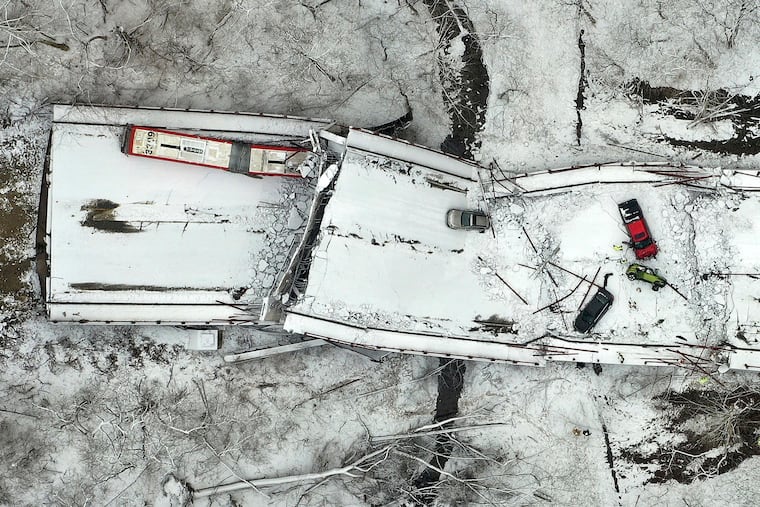A Pennsylvania bridge just collapsed. Which one is next? | Opinion
The provisions in Build Back Better will help prevent future disasters.

On Friday, a bridge that was built around 50 years ago collapsed in Pittsburgh, just hours before President Joe Biden’s visit to the city to promote his administration’s $1 trillion infrastructure plan. This collapse, which injured 10 people, shows that deferring maintenance has a toll on human life. Infrastructure investments keep Pennsylvanians safe.
I live in Pittsburgh’s East End, and I cross the Fern Hollow Bridge and stroll the wooded paths of Frick Park regularly. If schools had not been on a two-hour delay on that cold, snowy Friday morning, many more people could have been injured or killed.
Fern Hollow Bridge is only one of around 4,000 bridges in Pennsylvania that are classified as poor, meaning that structural elements have deteriorated significantly. The Pennsylvania chapter of the American Society of Civil Engineers 2018 report gave the state’s bridges a failing grade of D+, with one-fifth of our state’s bridges classified as poor, and our overall infrastructure a mediocre C.
This is dangerous. Without proper upkeep, bridges can collapse, the electricity grid can fail, and water systems can become contaminated.
The 2021 infrastructure bill will inject $17.8 billion into Pennsylvania’s infrastructure, with $1.6 billion earmarked for bridges. These investments will upgrade aging roads, rail, public transit, water and wastewater systems, and the electricity grid. Rep. Brian Fitzpatrick of Bucks County was the only member of Pennsylvania’s Republican congressional delegation to vote for the infrastructure bill, even though infrastructure investments have long enjoyed bipartisan support.
As with the rest of the United States, Pennsylvania is facing more frequent and severe extreme weather events induced by climate change. We are facing these events with aging infrastructure that was designed and built for past climate conditions. The Department of Environmental Protection’s “2020 Climate Change Impacts Assessment” warns of the multiple ways extreme weather will damage Pennsylvania’s infrastructure and threaten human lives.
Extreme rainfall and coastal surges cause severe flooding. Pennsylvania’s hilly and steep terrain increases the risks of landslides following heavy rains, which can wash away roads, rail, and bridges. Landslides can also damage underground infrastructure, including communication and electric distribution networks and gas pipelines.
These disruptions are happening already, and they are only going to get worse. With each narrow escape, we heave a sigh of relief, and with each tragedy, we express regret and pledge to do better next time.
The good news is that we have a bill in Congress that addresses this problem. The Build Back Better bill, passed by the House but stalled in the Senate, contains provisions that would invest in building America’s infrastructure for the 21st century. As Democrats revisit the bill to winnow provisions that can secure enough support in the Senate, Pennsylvania’s congressional representatives — particularly, Sen. Pat Toomey — should not forget that a bridge just collapsed in our own state. And beyond this immediate tragedy, there are provisions in the bill that will directly assist Pennsylvanians.
These provisions include funding for workforce development, coastal restoration in Southeastern Pennsylvania, and agricultural practices that can stem flooding throughout the state. Investments of this kind create jobs while also improving our resilience in the face of climate change.
It’s also important to remember that a line transporting natural gas ran under Fern Hollow Bridge. When the bridge collapsed, some residents near Frick Park had to evacuate because that gas was leaking. Luckily, the distribution line beneath the Fern Hollow Bridge was soon shut off.
I can’t help but think of this as a metaphor. Pennsylvania is the nation’s second-largest natural gas producer after Texas, but the natural gas industry has failed to provide the increases in jobs and income that it promised the region.
Pennsylvania needs to take steps to make an orderly transition away from dependence on fossil fuels. We can do so while creating good-paying jobs. The bill’s provisions invest both in the renewable energy and energy efficiency sectors — through incentivizing deployment and manufacturing — and in rebuilding our fossil fuel-reliant communities. For instance, the bill provides special incentives for clean energy facilities in energy transition communities.
As of Jan. 20, none of the 50 Senate Republicans said that they would support the climate provisions, even in a stand-alone bill. Sen. Mitch McConnell mischaracterizes these provisions as ”a reckless taxing and spending spree that would hammer American families.” In reality, Senate Republicans oppose fair strategies to pay for this spending, such as requirements on companies that provide $1 billion in profits to shareholders to pay a minimum tax rate of 15% on those profits, or requirements on publicly traded U.S. corporations to pay a 1% excise tax for the value of their stock buybacks.
Former President Donald Trump promised major tax cuts and infrastructure legislation but delivered only the tax cut. That tax cut, skewed in favor of the wealthy, will add $1.9 trillion to the deficit by 2028. By contrast, deficit spending for infrastructure investments, with careful oversight, will set Americans on the path to greater productivity and higher living standards. This is a prudent economic strategy.
Consider it a restored bridge to the future.
Shanti Gamper-Rabindran, author of “America’s Energy Gamble: People, Economy and Planet,” is an associate professor at the University of Pittsburgh.